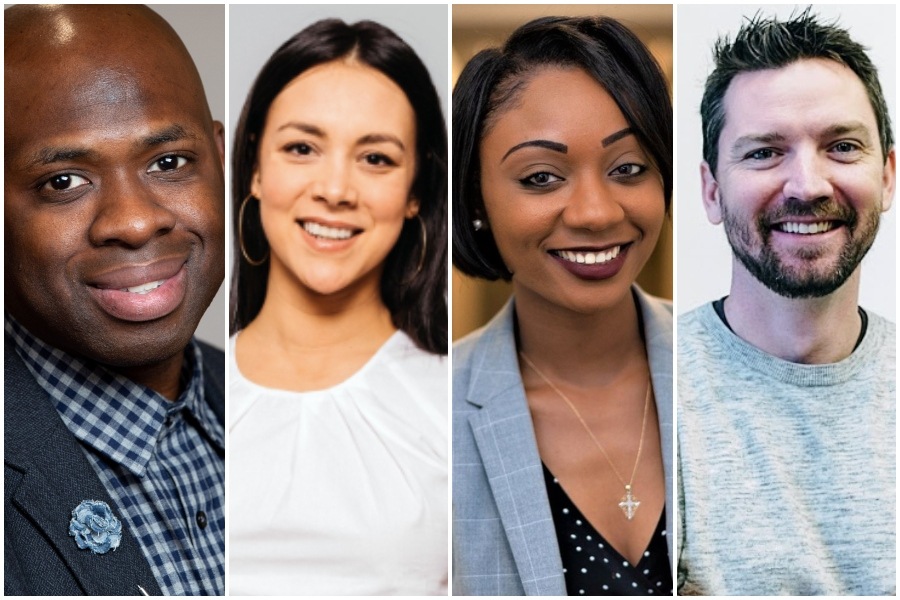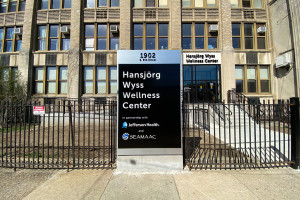4 Philly CEOs on What to Do If You’re Miserable at Work
These leaders tell us their stories of finding happiness with what they do, from a change in career to a change in perspective.

L to R: Bruce Marable, CEO, EmployeeCycle; Antoinette Marie Johnson, CEO, Cohere; Teresa M Lundy, founder and principal, TML Communications; Patrick Baynes, CEO, Updates Central
No job comes without moments of unhappiness, be it workplace drama, chronic imbalance or the classic battle between pay and fulfillment. So what do you do when you’re really unhappy? It can be tempting to quit, but hard if you’re lacking skills in another industry or just can’t afford to take a big leap. Four Philly CEOs tell us their stories of overcoming work unhappiness (yes, even CEOs question their jobs sometimes) and offer their advice for finding satisfaction.
Bruce Marable, CEO, EmployeeCycle
My advice: Find direction
I created my first tech startup while a student in college, and when that failed I ended up getting a corporate job after graduation. Although that doesn’t sound like the worst possible situation, to me it felt like I failed in life. After I got over my ego, I realized my job was an opportunity to learn as much as possible from the smart people around me, gain valuable corporate experience, and begin to build my professional network that hopefully would pay off in the future.
I’ve come to realize most people are unhappy not only because they don’t like what they’re doing, but also because they don’t know what they want to do. My advice is to create a vision board for your ideal work opportunity; have a North Star for the direction where you’re headed. Ask yourself every possible question about the type of work you want to perform. Do you want to travel for work? Corporate or relaxed environment? Startup or large company? Once you answer a lot of these questions, you should then be able to find the right opportunity for you.
Antoinette Marie Johnson, CEO, Cohere
My advice: Be a specialist
Early on in my career, I was a GIS analyst with a mapping company doing work for clients like Mapquest and Google. The career was rewarding in aspects like travel and technology education, but the growth of digital maps as a sector was skeptical. My appetite for creativity was not being fed, and I needed to be honest with myself about what would make me happy in the long term. I decided to take classes and teach myself graphic design, and before I knew it, my freelance career was in high demand for designing logos and websites. I took the plunge about three years into it and quit my full-time job to start a small creative agency. That agency is now Cohere.
A dear mentor once encouraged me to develop a completely unique set of skills and life experience, ultimately leading me to be an expert in urban placemaking and branding. I now give the same advice to young professionals: it takes 10,000 hours, which is the equivalent of 10 years, to become the go-to expert in something.
Design a sweet spot for yourself by creating a Venn diagram of two overlapping circles. Each represents five years, and in those, choose two passions you can see yourself spending countless hours on (mine were urban redevelopment and branding). Where they overlap becomes the niche you serve, the expert you can become. Clarify your intentions and you can claim that unique skillset in less time than most of your peers!
Patrick Baynes, CEO, Updates Central
My advice: Figure out what you want (and what you don’t)
After two years working at LinkedIn, I found myself not growing personally or professionally. I was filling my time running marathons and volunteering outside of work, but it wasn’t enough and I was bored.
When I started asking people for advice I learned a valuable insight about asking for advice: people will always tell you what they would do. So, if you’re looking for advice, try asking people who are where you want to be. They can show you the path and will tell you what you need to hear.
Happiness can come from many places, and it’s a lot easier to find when you know what to look for. When I graduated from college, I had no idea what I wanted to do, but I knew I didn’t want to change who I was for a job and wanted a laid-back culture where I could wear sandals to work. Internet company culture was simultaneously becoming well known, so those requirements helped me find what I wanted, seek out opportunities and eventually land at LinkedIn.
Teresa M Lundy, founder and principal, TML Communications
My advice: Do something more
Many years ago I was working in retail sales. After working in this industry for almost six years climbing the corporate ladder from sales associate to key-holder and management, I felt deep inside that I wasn’t happy or satisfied with my current career choice. I had to make a change. That first change began by splitting my time between college education and work, finding a balance that allowed me to experience new things and bring those experiences back into my workplace.
For me, dealing with my unhappiness and dissatisfaction meant finding a purpose in why I went to work, outside of the monetary fulfillment. I would tell others to remember the words from Dalai Lama XIV: “Happiness is not something ready-made. It comes from your own actions.”
People struggling to find happiness or purpose in their own career should take a weekend and re-evaluate their living. To exist in the present means you have to be present. After that, know that one of the best feelings is being a part of something bigger than yourself. Taking on a project, initiative or cause either locally or abroad will allow you to expand your horizon and find your balance. Before deciding to abruptly quit your career, seek out a non-profit organization where you can lend your expertise. The happier you make others feel, the easier it will be to restore that happiness back into your life.


